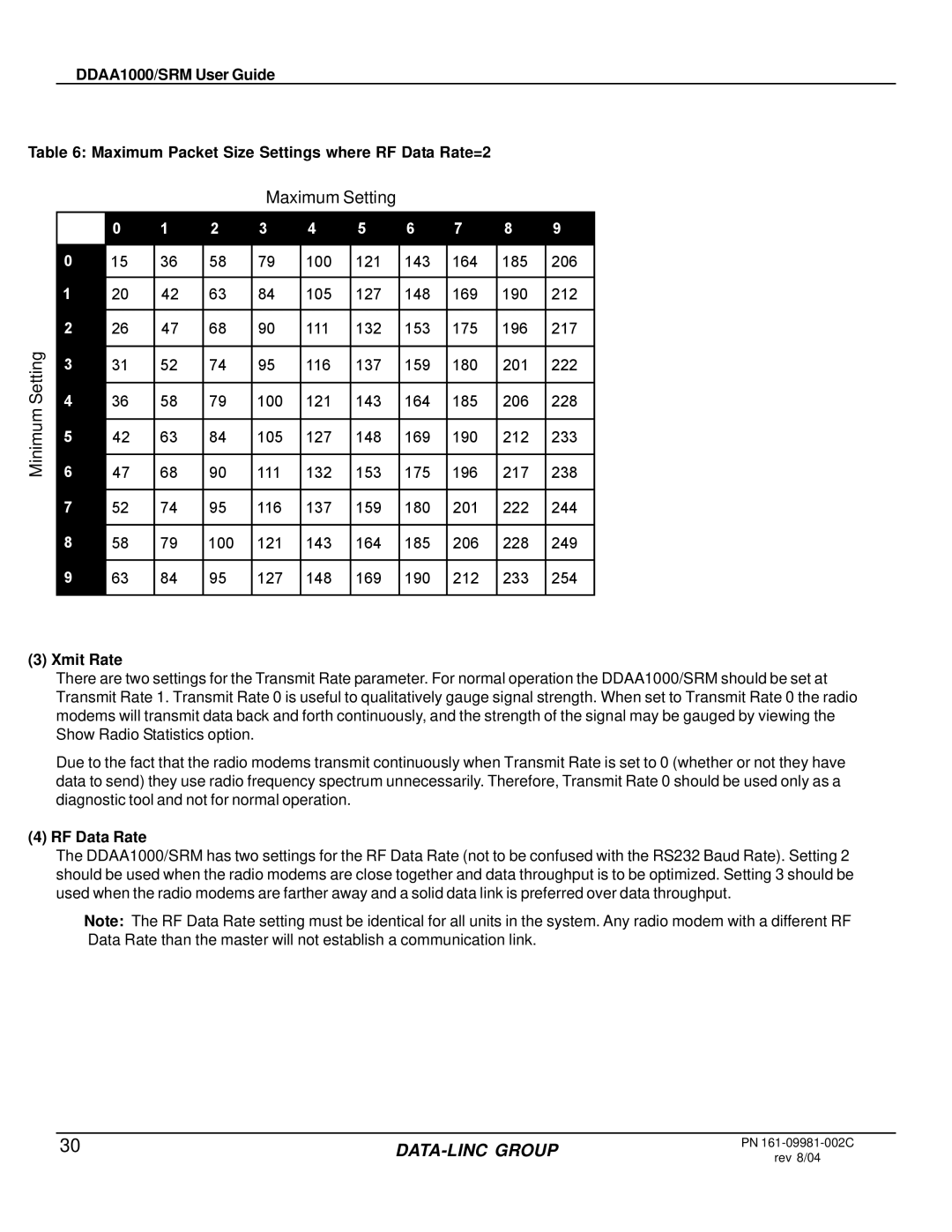
DDAA1000/SRM User Guide
Table 6: Maximum Packet Size Settings where RF Data Rate=2
Maximum Setting
|
| 0 | 1 | 2 | 3 | 4 | 5 | 6 | 7 | 8 | 9 | |
|
|
|
|
|
|
|
|
|
|
|
| |
| 0 | 15 | 36 | 58 | 79 | 100 | 121 | 143 | 164 | 185 | 206 | |
| 1 |
|
|
|
|
|
|
|
|
|
| |
| 20 | 42 | 63 | 84 | 105 | 127 | 148 | 169 | 190 | 212 | ||
| 2 |
|
|
|
|
|
|
|
|
|
| |
| 26 | 47 | 68 | 90 | 111 | 132 | 153 | 175 | 196 | 217 | ||
Setting | 3 |
|
|
|
|
|
|
|
|
|
| |
31 | 52 | 74 | 95 | 116 | 137 | 159 | 180 | 201 | 222 | |||
| ||||||||||||
| 4 |
|
|
|
|
|
|
|
|
|
| |
Minimum | 36 | 58 | 79 | 100 | 121 | 143 | 164 | 185 | 206 | 228 | ||
6 |
|
|
|
|
|
|
|
|
|
| ||
47 | 68 | 90 | 111 | 132 | 153 | 175 | 196 | 217 | 238 | |||
| 5 | 42 | 63 | 84 | 105 | 127 | 148 | 169 | 190 | 212 | 233 | |
| 7 |
|
|
|
|
|
|
|
|
|
| |
| 52 | 74 | 95 | 116 | 137 | 159 | 180 | 201 | 222 | 244 | ||
| 8 |
|
|
|
|
|
|
|
|
|
| |
| 58 | 79 | 100 | 121 | 143 | 164 | 185 | 206 | 228 | 249 | ||
| 9 |
|
|
|
|
|
|
|
|
|
| |
| 63 | 84 | 95 | 127 | 148 | 169 | 190 | 212 | 233 | 254 | ||
|
|
|
|
|
|
|
|
|
|
|
|
(3) Xmit Rate
There are two settings for the Transmit Rate parameter. For normal operation the DDAA1000/SRM should be set at Transmit Rate 1. Transmit Rate 0 is useful to qualitatively gauge signal strength. When set to Transmit Rate 0 the radio modems will transmit data back and forth continuously, and the strength of the signal may be gauged by viewing the Show Radio Statistics option.
Due to the fact that the radio modems transmit continuously when Transmit Rate is set to 0 (whether or not they have data to send) they use radio frequency spectrum unnecessarily. Therefore, Transmit Rate 0 should be used only as a diagnostic tool and not for normal operation.
(4) RF Data Rate
The DDAA1000/SRM has two settings for the RF Data Rate (not to be confused with the RS232 Baud Rate). Setting 2 should be used when the radio modems are close together and data throughput is to be optimized. Setting 3 should be used when the radio modems are farther away and a solid data link is preferred over data throughput.
Note: The RF Data Rate setting must be identical for all units in the system. Any radio modem with a different RF Data Rate than the master will not establish a communication link.
30 |
|
PN
rev 8/04
